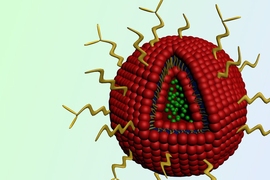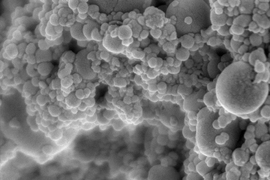As a chemical engineer, Paula Hammond began her career getting tiny polymers to transform when heated or stretched — by changing color, for example. But her passion turned to using those techniques to promote healing. That led her to engineer better bandages for wounded soldiers and design better carriers for cancer treatments.
"The reason that biomedical applications have been exciting to me is that a number of the things that we're working on actually get us closer to delivery to the patient or to a real application in which we can affect lives," says Hammond, the David H. Koch Professor in Engineering at MIT.
"Lung cancer has affected my relatives in a special way, so I'm very aware of the impact of cancer on people and on families," Hammond explains. Hammond, who is a core faculty member of the Koch Institute for Integrative Cancer Research, was also a founding member of the Institute for Soldier Nanotechnologies.
Targeting ovarian cancer
Hammond’s newest collaborations targeting ovarian cancer are with Michael J. Birrer at Massachusetts General Hospital and Ronny Drapkin at Dana Farber Cancer Institute. These partnerships grew out of Hammond’s sabbatical in 2013, and were prompted by support from a $3.7 million, five-year Teal Innovator Award, funded by the U.S. military’s Ovarian Cancer Research Program. In Hammond’s group, postdocs Young Hoon Roh and Kevin Shopsowitz are working with Birrer at MGH.
“Ovarian cancer in particular is compelling to me because it’s one of the few cancers where we haven’t made real progress in 30 or 40 years, so that the death rates are still about the same,” Hammond explains. “Part of that has to do with detection issues, and part of that has to do with the ability to address what is typically a very advanced and aggressive form of tumor, advanced serous ovarian cancer, that seems to have several modes of defense against traditional chemotherapy.”
Although the initial tumor can be eliminated in 70 to 80 percent of patients through chemotherapy, the cancer comes back in a large percentage of patients. “In its recurrent form, it’s derived from the survivor cells that are extremely resistant to traditional chemo approaches,” Hammond says.
Drapkin says Hammond’s biomaterials work is complementary to his own at the Dana Farber Cancer Institute. “We address and attack the problem from a different angle. We try to identify oncogenes and biomarkers of aggressive disease that might be targets for therapy,” Drapkin explains. He is working with Erik C. Dreaden in Hammond’s group. Hammond took part in Drapkin’s weekly research group meetings during her recent sabbatical.
Because Hammond’s layer-by-layer nanoparticles can deliver both an RNA agent to block a particular cancer gene and an anti-cancer drug at the same time, “It’s a nice way of being able to do multiple things at once without having to develop new drugs or compounds,” Drapkin says. Drapkin will test the layer-by-layer nanoparticle technology against P53 genes, which are the most commonly mutated genes in ovarian cancer. Experiments will test whether the nanoparticles are effective against human ovarian cancer cells injected in the abdomens of mice since ovarian cancer typically spreads to the abdomen. Mice often can serve as faithful models of human disease, he says. If researchers can wipe out mutant P53 genes, that would be potentially important in terms of all other cancers, Drapkin says.
As part of the Teal Innovator Award, Hammond is organizing a symposium that will take place at the Koch Institute on Sept. 16 to reach out to ovarian cancer survivors and advocates. "I'm hoping to learn from their experiences and hoping to talk to them about how technology can change things," Hammond says.
Progress in the lab
Combination therapies developed in Hammond's lab show promise in stronger cancer-killing ability.
• A collaboration between Hammond and Michael B. Yaffe showed that time-staggered release of two chemotherapy drugs, erlotinib and doxorubicin, from a nanoparticle with folate attached to its shell, shrunk tumors in mice. The folate helps the nanoparticles bind to receptors on cancer cells. The study targeted two hard-to-treat cancers, human triple-negative breast cancer and non-small cell lung cancer. Lead co-authors of the study were Hammond's graduate student Stephen W. Morton and Michael J. Lee in Yaffe's group.
• A separate study, led by Zhou J. (Jason) Deng, a postdoc in Hammond's group, demonstrated the strength at fighting triple-negative breast cancer of a layered nanoparticle with a drug-loaded core and an outer wrapping containing siRNA (short interfering RNA). The siRNA shuts down a gene on the cancer cell that kicks out chemotherapy drugs. The team used layer-by-layer assembly developed in Hammond's lab to build the nanoparticle.
Layer-by-layer assembly allows the researchers to use material properties such as water repulsion or attraction and positive or negative electric charge to control drug release from the core, and biological properties such as genetic characteristics to target specific cancer cells. This approach has the advantage of increasing drug strength against tumor cells and decreasing harmful side effects. The design allows adding layers that target particular receptors on the cancer cell or that promote passage through the body toward cancer cells. One such coating is hyaluronic acid, which researchers call a "stealth coat."
"In all of these approaches, we're looking at what the targets of these ovarian cancers are," Hammond says. "We are working with folks at MGH and folks at Dana Farber to understand which genetic changes in these tumor cells are the ones we could target that could make those tumor cells more susceptible to a chemotherapy attack — or in combination, which set of genes might we target such that when you shut all of these genes down, the tumor cells will no longer live. In doing that, you can create very specific targeting of ovarian cancer cells."
A cancer gene called MRP1 (multidrug resistance protein 1) produces a protein that pushes out a chemotherapy drug such as doxorubicin, creating a self-defense mechanism for the cancer. In the triple negative breast cancer study, Hammond explains, "They actually actively pump out doxorubicin as it arrives, so these tumor cells are sort of like when a baby spits out the medicine. They are ejecting the doxorubicin, but that's done by a protein that acts as a pump that the tumor cells generate."
To knock down that MRP1 gene, researchers put the siRNA on the outside of the nanoparticle and the doxorubicin on the inside of the nanoparticle. “The siRNA releases a little faster than the doxorubicin and so when it gets into the cell, the idea is the siRNA would knock down the pump and the doxorubicin would be released not long thereafter, and it would actually have real impact on the tumor cell,” Hammond explains.
Identifying specific targets on cancer cells and engineering siRNA targeted against them holds the promise of personalized cancer treatment based on individual cancers. All of the cancer studies to date are preclinical studies in mice and may need to be validated in larger animal studies such as dogs or sheep before moving into human clinical trials.
Going to Market
Cancer is one of several lines of research in Hammond's lab. The group previously developed a sponge coated with thrombin, a blood-clotting enzyme, to stop bleeding within a minute; created coatings that promote bonding for artificial implants to natural bone; and developed scaffolding coated with bone growth factor using layer-by-layer technology to restore damaged bone.
Last fall, Hammond and her partners launched a new company, LayerBio Inc., to commercialize its patented LayerForm technology for implant and wound healing applications. Target areas for new products include wound care and eye care — for example, drug-coated implants for cataract lens replacement that currently have to be applied as drops after surgery. Hammond serves as Chair of LayerBio's Scientific Advisory Board.
Inspiring the next generation
As an African-American woman, Hammond is aware of obstacles to a career in science. "One of the things that happens when you're a minority, when you're a woman, is that the environment around you can sometimes be less affirming, and you begin to doubt yourself, and your skillset and abilities," Hammond explains. "In many cases at the top echelons of science and engineering, your environment may be telling you that you are not the most likely person to be involved in this effort, you're not the most likely student in this classroom to know the answer, you're not the most likely candidate for this position. You have to counter that. You have to actively let yourself know that, actually, you are qualified, that you do know what you're talking about. It takes a while to condition yourself to do that. When young people are entering the field, they need to know that there have been, intentional or not, forces that often push us away from these fields because people expect something different. Being able to get beyond that and show your skills and get engaged without fear is really important. Just dive in and do it; get involved."
Engaging with young people who are getting excited about the field is very important to Hammond. "I think it's important for them to just know that there are people out here like myself and like my colleagues who are doing this kind of work and enjoying it, that it's an incredible adventure and that it is satisfying in many different ways. It's about the science, but it's also about the ability to get extremely excited about an idea and make it come true. It's about being able to partner with other people who have great ideas and bringing something forward based on that," she says.
An agent of transformation at MIT
Hammond is excited that her group will soon be able to use the Institute's new MIT.nano facilities for imaging soft materials and colloidal materials, including her cancer-fighting nanoparticles. "We anticipate being able to use them to look at some of the biomaterial scaffolds we have, and to image some aspects of our nanomaterials systems," she explains. "There will also be some biosafety and vacuum hoods in prep rooms that allow you to prepare the soft samples, including cell-based and biological samples, something that you can't do as easily in the current setup. So you can bring your wet, soft, organic stuff into the lab and do a little sample prep and make your measurement and that's going to be really enabling."
When she was a doctoral student in chemical engineering at MIT, Hammond was advised by Professor Michael Rubner in the Department of Materials Science and Engineering. "My graduate work was on thermochromic materials and mechanochromic materials. They were materials that were polymers, but along their backbone, they had conjugated chains, which absorbed light in a certain wavelength, and when you stretched them or heated them up, they would undergo a change in the way that they were arranged. That would lead to a change in the wavelength of light they absorbed, so they'd change color when you stretched them and when you heated them," Hammond explains. "That fascinated me because I was really interested in the ability to design something that undergoes a transformation." She's been transforming things ever since.












